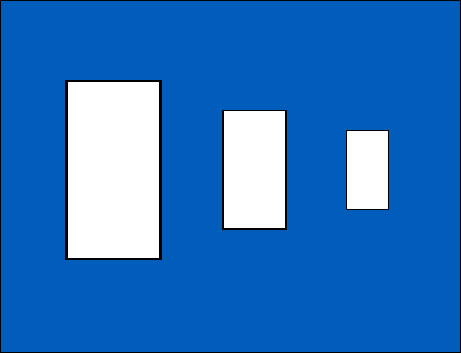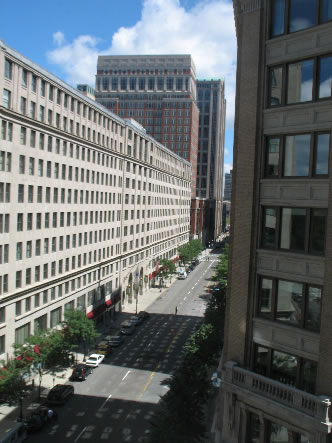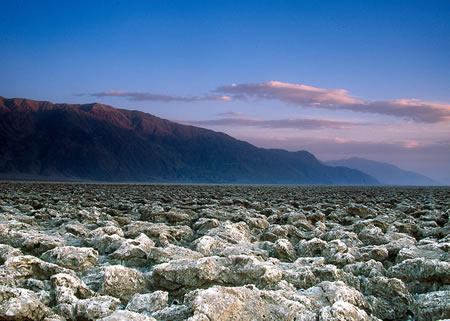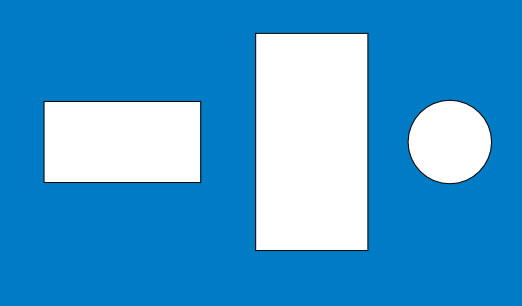Do smaller things appear farther away?
- Details
- Last Updated: Sunday, 23 August 2015 10:54
- Written by Dr. Donald H. Mershon
Summary: If we use the word "smaller" to refer to the magnitude of the visual image, then it is generally the case that smaller versions of similar shapes will appear farther away in a given scene. Such relationships go by several names, including relative size, linear perspective, and texture gradients. Examples of each sort of "cue" are provided and both their commonalities and differences are described.
This is one of those questions that must be answered first by another question. As we discussed in an article about the language of perception (Intro to basic distinctions in the field), everything depends upon what one really means by "small."
Of course, the physical size of any solid object remains generally the same, regardless of our position. We could have a walnut and an elephant beside one another and we would not necessarily see a difference in distance. Clearly, the physical sizes do not force us to see variations in perceived distance; the walnut simply looks small and the elephant looks big.
The critical measure that will help us answer our original question is the angular size of related objects. Specifically, when we have multiple such objects visible at once, those with images that take up less room on our retina will often appear farther away. (As always, such a statement must be qualified by "other factors not interfering.")
There are actually at least three sources of distance information (aka "cues") that depend upon the angular sizes of images. Traditionally, these have been called the relative size cue, the linear perspective cue and the texture gradient cue. (There is also a somewhat different factor, called the familiar size cue, which may aid both to see the depth within a scene, as well in perceiving the scene's overall scale. Unlike the others, however, familiar size depends upon additional information, probably dependent upon past experience.)
To be more specific, we use the term relative size cue, whenever there are at least two similarly shaped objects in view. We use linear perspective to indicate that the situation involves continuous lines, edges or a series of many of the same kind of object. Texture gradients are said to occur, if a scene is composed of many separate elements, usually spreading out in two dimensions. Texture gradients can also describe the existence of systematic variation in the separation of edges. For example, if horizontal lines are vertically positioned closer and closer together, they may readily appear as a surface extending in depth. Let's consider each of these cues in turn and then try to tie them into a cohesive package.
Small sets of similar objects
The relative size cue is illustrated in Figure 1 – a group of three, similar rectangles. If one did not have other types of information available (like the equality of focus/vergence, and a lack of both binocular disparity and motion parallax), the rectangle on the left would look closer than the one in the middle, which would look closer than the one on the right. Note that the similarity of shape is important. It is not just a change in angular size that creates the apparent depth; if the objects can easily be seen as independent, they may simply look larger or smaller, rather than at different distances.
Figure 1
Illustration by author.

Continuous change in lines/edges
If one looks down a city street (see example in Figure 2, there are many lines in the image that converge toward a common point (the "vanishing point"). The sides of the street, the sidewalks, the traffic lanes and, depending on one's own vantage, even the foundations or markings on buildings, have smaller angular separations from one another as one scans across the image. In addition, there are often many groups of objects that share common shapes (automobiles, windows, trees, utility poles, and so on.
You probably noticed that what I've called the relative size cue and the figure I've used as an example of linear perspective have some overlap. This is true, but as we'll see, it is essentially a matter of choice when one shifts from the first to the second label.
Figure 2
Photo by author.

Texture change can be very effective
Imagine a surface such as a beach strewn with rocks. The rocks vary randomly in their physical sizes, as well as in their angular sizes. In the situation illustrated by Figure 3, however, the average physical sizes of the rocks are roughly the same no matter where one looks. Hence, the average size of the rock images is decreasing from one portion of the scene to another. In this case, from the lower-edge toward the upper. Once again, the change in angular size creates the appearance of a surface that extends in depth.
Figure 3
Devil's Golf Course, Death Valley CA, illustrating effects of texture gradient.
Photo: Robert J. Haines

Tying the cues together
If we use the symbols that have been described in the language of perception, the reason for connecting the above three cues is pretty straight forward.
In each example, there are changes in angular size or separation. Thus, the value indicated by the Greek letter theta (θ) decreases from one part of the scene to another. The differences in angular size or separation produce the appearance of increasing distance (D'). Or, to provide a handy visual reminder, one might state:

Considered in this manner, there is basically only one relationship that is operating. The use of the three different labels is more a matter of convenience than substance. They help describe the sort of information providing the sense of depth: a relatively few similar objects, lots of objects or continuous lines/rows, or a wide-spread field of systematic changes in average image size.
Some final notes
I noted above that the relative size cue (and probably some linear perspective situations) required that the objects involved must be similarly shaped. Without a perceptual connection between the objects, it is likely that factors such as the other cues mentioned, as well as the Equidistance Tendency, would tend to draw the objects together in depth.
As discussed in the article on Phenomenal Geometry, objects that have different angular sizes – but which all seem to be near the same distance – will primarily appear to vary in apparent size. Figure 4 shows three objects that vary in shape; do they appear to vary in apparent distance as much as the earlier examples?
Figure 4
Illustration by author.






